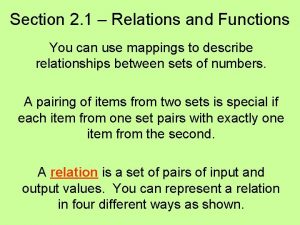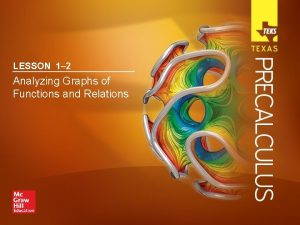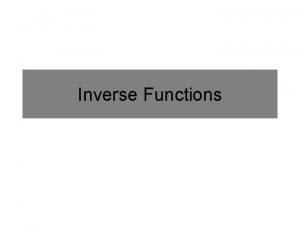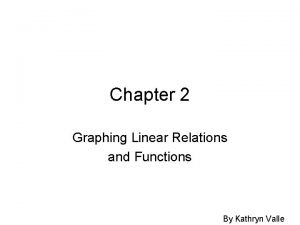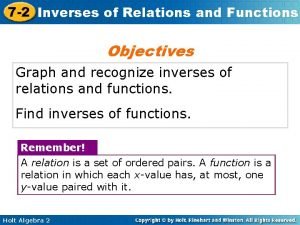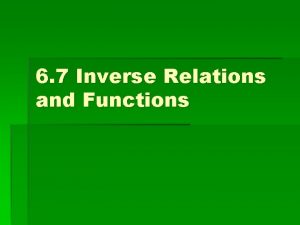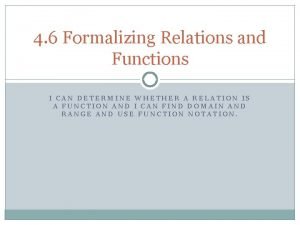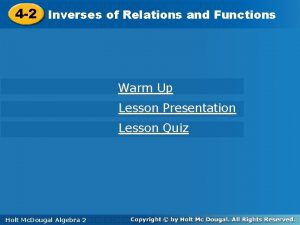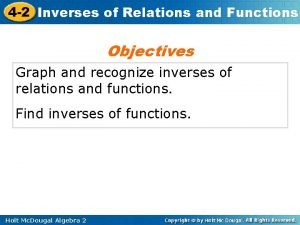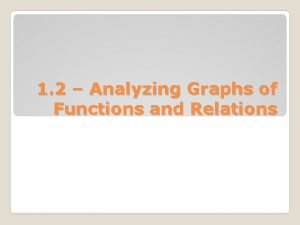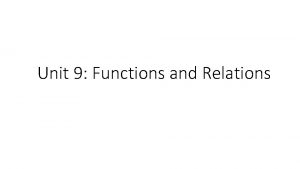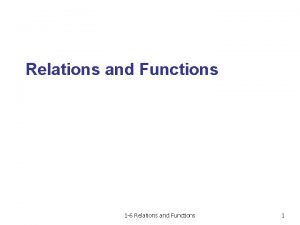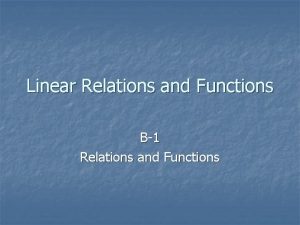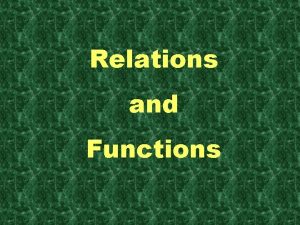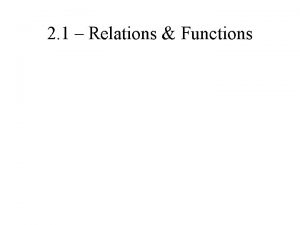Chapter2 Relations And Functions This Presentation contain The










- Slides: 10

Chapter-2 Relations And Functions This Presentation contain The following Topics: v. Ordered Pair v Cartesian Product of Sets v. Relations

Ordered Pair : - An ordered pair is a pair of objects taken in a specific order. An ordered pair is written by listing the two members in a specific order, separating them by comma and enclosing the pair in parenthesis. Ex. In the ordered pair (a, b) , a is called the first element or member and b is called the second element or member. Cartesian Product of Two Sets Let A and B be any two non- empty sets , then the set of all ordered pairs (a, b) for all a Є A and b Є B is called the cartesian product of A and B. => A x B = { (a, b) : a Є A and b Є B } Ex. Let A = { 1, 2, 3} and B = { 3, 4} Then A x B = { (1, 3), (1, 4), (2, 3), (2, 4), (3, 3), (3, 4)} And B x A = { (3, 1), (3, 2), (3, 3), (4, 1), (4, 2), (4, 3)}

From the example we can observe that : (i) A x B ≠ B x A (ii) n(A x B ) = n(A) x n(B) = 3 x 2 = 6 Note : 1) A x B ≠ B x A unless A = B 2) A x B = ɸ , when one or both of A, B are empty sets. 3) If A and B are non- empty finite sets then , n(A x B ) = n(A) x n(B) and n(A x B) = n(B x A ) 4) If A and B are non- empty sets and either A or B is an infinite set, then A x B is also an infinite set. If A, B and C are three non- empty sets then (A x B x C) ={ (a, b, c): aЄ A , b Є B and c Є C } And n(Ax. Bx. C) = n(A) x n(B) x n ( C )

Relations Consider the two sets P = { a, b, c} and Q = {Ali, Binoy, Bhanu, Chandra} Then P x Q = {(a, Ali), (a, Binoy), (a, Bhanu), ……. (c, Chandra } = 12 ordered pairs. Now we can obtain a subset of Px. Q by introducing a relation R between P and Q such That R = { (x, y): x is the first letter of the name y, x Є P , y Є Q} Then R = { (a, Ali), (b, Binoy), (b, Bhanu), (c, Chandra)} Definition : - A relation R from a non-empty set A to a nonempty set B is a subset of the cartesian product A x B. The subset is derived by describing the relationship between the first element and second element of the ordered pairs in A x B.

• A relation R : A ----> B can also be represented by arrow diagram as shown below : A B • a • Ali • b • Bhanu • Binoy • c • Chandra In the above fig. the elements of the set B are called the image of the element of the set A. Eg. Image of ‘a ‘ is ‘Ali’ etc. This is the graphical or pictorial representation of the relation R from A to B. Also known as arrow diagram.

From the relation R : A ---> B we have three most important terms, which are as follows : 1. Domain : - The set of all first elements of the ordered pairs (a, b) in the relation R is called the domain of the relation R. For example in the above relation { a, b, c} is the domain. 2. Range : - The set of all second elements of the ordered pairs (a, b) in the relation R is called the range of the relation R. for example in the above relation { Ali, Binoy, Bhanu, Chandra} is the range. 3. Co-domain : - The second set as a whole is called the codomain. Eg. In the above relation set B is co-domain. So we can say that “range is the subset of co-domain”.

Some Examples of Relations Example 1. Let A = { 1, 2, 3, 4, 5, 6}. Find the relation R from A to A defined by R = { (x, y) : y = x+1, x , y Є A } i. Represent this relation by arrow diagram. ii. Find Domain, Range and Co-domain, of the relation. Solution : we have given the set A = { 1, 2, 3, 4, 5, 6} and the relation R = { (x, y): y = x+1, x, y Є A }. From this we get R = { (1, 2), (2, 3), (3, 4), (4, 5), (5, 6)} The arrow diagram is shown bellow from the fig. we can see that • 1 Domain = { 1, 2, 3, 4, 5, 6} • 2 • 3 Range = { 2, 4, 5, 6} • 4 Co-domain = { 1, 2, 3, 4, 5, 6} • 5 • 6

Example 2: - The fig. shows a relation between P and Q. write this relation i. In the set builder from. ii. In roster form. iii. Also write its domain and range. P • 9 • 4 Q i. ii I • 3 • 2 • 1 • -2 • -3 Solution: - from the fig. we can see that ‘ elements of P are squares of element of Q’ i. In set builder form R = { (x, y): x is square of y , x Є P, y Є Q} ii. In roster from R = { (9, 3), (9, -3), (4, 2), (4 , -2)} iii. Domain of R = {9, 4} and Range = { 3, 2, -3, -2 } Example 3: - If a relation R = { (0, 0), (2, 4), (-1, -2), (3, 6), (1, 2)}. Then write : (i) Domain and Range of R (ii) R in set builder form (iii) represent R in arrow diagram.

Soution : - we have given that R ={ ( 0, 0), (2, 4), (-1, -2), (3, 6), (1, 2)} i. Domian = { 0, 2, -1, 3, 1} and Range = { 0, 4, -2, 6, 2} ii. R in the set builder form R = {(x, y): y = 2 x, -1 ≤ x ≤ 3, x Є Z} iii. The relation can be represented by arrow diagram as shown bellow. A B R • 0 • 2 • -1 • 3 • 1 • 0 • 4 • -2 • 6 • 2 Example 4: - If A = { 1, 2, 3, …. , 14} and a relation R is defined from A to A by R = { (x, y) : 3 x – y = 0 , x , y Є A}. Then write

(i)R in roster form (ii) its Domain , Range and Co- doamain Also represent the relation by an arrow diagram. Solution : - Given A = { 1, 2, 3, …. , 14} and R = {(x, y): 3 x – y =0, x , y Є A } i. R in roster form : R = {(1, 3), (2, 6), (3, 9), (4, 12)} ii. Domain = {1, 2, 3, 4} , Range = { 3, 6, 9, 12} and Co-domain is the set A. iii. The arrow diagram of the relation R is given bellow: A A 1 2 3 4 5 6 7 8 . 3. 6. 9. 12
 Employee relations in public relations
Employee relations in public relations Relation and function
Relation and function Analyzing graphs of functions and relations answers
Analyzing graphs of functions and relations answers Domain and range of tan function
Domain and range of tan function 2-2 practice linear relations and functions
2-2 practice linear relations and functions 7-2 inverses of relations and functions
7-2 inverses of relations and functions Inverse variation graph calculator
Inverse variation graph calculator Unit 5 lesson 6 formalizing relations and functions
Unit 5 lesson 6 formalizing relations and functions 4-2 inverses of relations and functions
4-2 inverses of relations and functions 4-2 inverses of relations and functions
4-2 inverses of relations and functions Analyzing graphs of functions
Analyzing graphs of functions

